Round 2 FY 2014: Capital Improvements
At the first of three work sessions scheduled on next year’s budget, the Ann Arbor city council was briefed on about $95 million worth of capital improvements to be undertaken over the next two years. That amount is roughly evenly split over fiscal years 2014 and 2015.
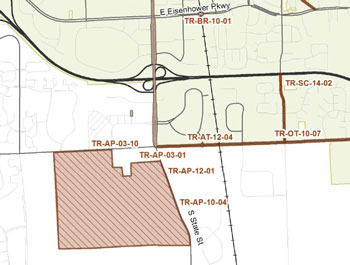
An excerpt from the city of Ann Arbor’s capital improvements plan. TR-AT-12-04 is a pedestrian crossing of Ellsworth at Research Park Drive, near the Center for Independent Living. TR-AP-10-04 is a runway extension at the municipal airport – the brown shaded area.
Generally, about 58% of funding for these projects comes from utility fees and dedicated millages, and 39% from state or federal funds, leaving about 3% to be covered by the city’s general fund. In dollar figures, the amount of improvements that will tap the city’s general fund – or for which funding is otherwise not yet identified – is greater for the second year of this two-year budget cycle. For FY 2015, about $3.4 million of the needed capital improvements will either need to come from the general fund or have some other yet-to-be-determined funding source.
For FY 2014, the amount needed from the general fund or as-yet-undetermined sources is closer to $1.3 million. The city of Ann Arbor’s total general fund budget is around $80 million.
The projects range across the broad categories of: (1) municipal facilities (buildings, parks); (2) transportation (streets, sidewalks, paths, parking decks, train station); and (3) utilities (sanitary, storm, and drinking water).
Cresson Slotten – a city engineer and manager for the city’s systems planning unit – gave the capital improvements briefing to the city council on Feb. 11. The presentation was based on the city’s capital improvements plan (CIP), which was approved by the city planning commission on Dec. 18, 2012.
Slotten also briefed the council on three significant study initiatives related to water systems – a city-wide stormwater study, a more focused study on the Malletts Creek watershed, and a sanitary sewer flow study. Those studies are part of the current year’s work.
In the course of Slotten’s presentation, councilmembers had questions about specific projects, including the footing-drain disconnection (FDD) program. Stephen Kunselman (Ward 3) noticed the FDD program has no funding indicated beyond the $2.5 million that’s called for next year, in FY 2014. Craig Hupy, the city’s public services area administrator, explained that the contract recently authorized by the council to study sanitary sewer flows would inform possible funding in future years.
Another project that drew scrutiny from councilmembers was a $540,000 for interim parking to support a possible commuter rail demonstration project. The city of Ann Arbor has told the Michigan Dept. of Transportation that it expects MDOT to pay for that parking. And Mike Anglin (Ward 5) asked for clarification of the $2.6 million slated for FY 2015 for the design of the “Ann Arbor Station.” City staff clarified that the location of a possible new Amtrak station is currently still the subject of a council-approved $2.75 million study, 20% of which the city is funding, with the remaining 80% covered by a federal grant.
A new station has been controversial in part due to an initially proposed location on Fuller Road near the University of Michigan hospital – on land designated as city parkland. In the CIP, the construction of such a new station is $44.5 million, slated for FY 2016. That cost was not included in the figures presented by Slotten, which went only through FY 2015.
The city council chambers appear in the CIP in connection with two capital projects. A renovation to the chambers – pegged at $300,000 in FY 2015 – seemed to meet with scant enthusiasm from councilmembers. Likely to have a bit more traction with the council is the remaining asbestos abatement in the city hall building. Asbestos abatement was partly completed when renovations were done in connection with construction of the adjoining Justice Center. For the city council chambers portion of city hall’s second floor, abatement would cost about $200,000, and is included in the CIP for FY 2014.
A query from Christopher Taylor (Ward 3) about Barton Dam projects drew out the fact that two projects listed for the concrete and steel portions of the dam – a two-year total of about $1.65 million – could be joined by additional work that might be required on the adjoining earthen berm. The berm is part of the dam that holds the water in Barton Pond, the main source of the city’s drinking water. The possible berm project depends on the outcome of investigatory work that’s being done at the behest of the Federal Energy Regulatory Commission (FERC).
A runway extension at the municipal airport – included in the CIP for FY 2014 at a cost of $2.14 million – was met with the observation from Sabra Briere (Ward 1) that an environmental assessment (EA) had not yet been acted on by the Federal Aviation Administration. The council had approved the last bit of funding for that study on Aug. 20, 2012. Without the finalized EA in place, Briere ventured, it would be difficult for her to vote for a capital budget that included the runway project.
The budget on which the council will vote this year will include a separate breakout of capital spending. The substantive conversation about the capital budget as it relates to the council’s established priorities is expected to begin to unfold at the council’s March 11 work session. Before then, a second work session is scheduled for Feb. 25, with an additional session slated for March 25, if necessary. Other topics discussed at the Feb. 11 work session included the 15th District Court and the Ann Arbor Housing Commission. Presentations on those topics are covered in separate Chronicle reports.
City administrator Steve Powers is required by the city charter to submit his proposed budget to the council by the second meeting in April, with any council amendments required by the second meeting in May. The city’s fiscal year begins July 1.
CIP Overview
Across all categories, a breakdown of funding requirements for capital improvement projects presented by Cresson Slotten include the following:
Category
FY 2014 FY 2015
City-Owned Buildings $1,113,000 $1,610,500
Parks and Recreation $3,475,000 $3,375,000
Solid Waste $40,000 $240,000
Airport $2,301,000 $569,000
Alt Transportation $2,176,000 $5,208,000
Bridges $412,000 $2,281,440
New Street $0 $1,125,000
Other Transportation $950,000 $400,000
Parking Facilities $430,000 $400,000
Street Construction $13,704,000 $10,230,300
Sanitary System $8,765,000 $8,260,000
Stormwater Mgmt $4,400,000 $5,260,000
Water System $11,400,000 $6,540,000
--------------------------------------------
TOTALS $49,166,000 $45,499,240
-
Wet Weather Projects
Cresson Slotten led off the capital improvements discussion with a description of three current wet-weather study projects, which involve sanitary sewers and stormwater sewers. The drinking water system is not part of the mix for this set of projects – but is included in the CIP for the next two years for a total of about $15 million per year.
Wet Weather: Sanitary Flow
The city of Ann Arbor has separate sanitary and stormwater conveyance systems. But as Cresson Slotten characterized it to the city council at its Feb. 11 work session: “Water doesn’t care which system it’s in – it just wants to get to the river.”
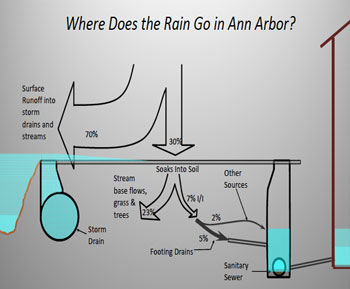
Where rain goes: 70% runs off, and 23% soaks in, becomes part of underground flows or is absorbed by vegetation. It’s the remaining 7% of the rainwater that causes a problem for the sanitary sewer system – because the sanitary system is not designed to handle that kind of volume. (Diagram from the city of Ann Arbor.)
However, during construction of new developments before 1980, footing drains – permeable pipes buried around the perimeter of a foundation, roughly at the depth of a basement floor – were frequently connected directly to the sanitary sewer pipes. Those connections were convenient to make, because the footing drains and the sanitary sewers are buried at roughly the same depth.
However, during very heavy rains, that configuration leads to a volume of stormwater flow into the sanitary sewer system that it’s not designed to handle. That can cause two problems.
First, near the point where the extra water is entering the sanitary system, it can cause raw sewage to back up through the floor drains of basements.
Second, farther downstream at the wastewater treatment plant, the amount of water flowing into the plant can exceed the plant’s capacity. That can result in only partially-treated wastewater being discharged into the Huron River.
It was wastewater discharges into the river that led the city to agree to an administrative consent order with the Michigan Dept. of Environmental Quality (MDEQ) to establish a way to offset the impact of new connections to the sanitary system required by new developments.

Footing drain disconnect (FDD) priority area in the southwest of Ann Arbor. Other priority areas, where nearly all the disconnections have been completed, lie in the northeast part of the city. (Diagram from the city of Ann Arbor.)
That program essentially requires developers who are building projects that place additional burdens on the sanitary sewer system to pay for a number of footing drain disconnections elsewhere in the city, according to a formula. The council’s Aug. 18, 2003 resolution authorized the consent order with the MDEQ.
The footing drain disconnect program was targeted initially in five neighborhoods that accounted for about half of all reported basement sewage backups.
Since implementation, 2,538 footing drains have been disconnected, including nearly all of the houses in three of the five areas. In the two other areas, between 55% and 60% of footing drains have been disconnected.
The city council decided on Sept. 17, 2012 to suspend temporarily the footing drain disconnection program.
And at its Feb. 4, 2013 meeting, the city council authorized a roughly $1 million study of Ann Arbor’s sanitary sewer flows – meant to assess the impact of the decade-long footing drain disconnection program. The point of the study is to see how well the FDD program has worked: Has it had more impact or less impact than expected? Have residents’ preferences changed with respect to how they’d like to see the issue addressed?
Wet Weather: Mallets Creek, Stormwater
The decision to suspend the FDD program came in the context of resident complaints.
In one of the remaining areas for the FDD program – the Glen Leven neighborhood – overland flooding during heavy rains in the spring of 2012 resulted in basement flooding in some houses that had been included in the FDD program. The FDD procedure includes the installation of a sump to collect water from the footing drains – which previously fed into the sanitary system – and a pump to move the water from the sump to the stormwater system. And in some cases, the pumps were reportedly not able to keep up with the influx into the footing drains.
Emphatic protest came from residents of that neighborhood, which has in recent weeks included rumblings of possible litigation. The litigation would be based on the legal theory that the city’s footing drain disconnection program has proceeded without valid contracts with homeowners, and that the installation of the wells and pumps constitutes an illegal “taking.”
The immediate cause of the overland flooding itself, however, likely includes the fact that the houses were built in an area through which a creekbed has historically flowed. [.jpg of image showing present-day development overlaid on aerial photography from the 1940s]
In that context, on Aug. 9, 2012, the council considered a resolution directing city staff to start negotiations with the Washtenaw County water resources commissioner to identify “opportunities for stormwater conveyance and stormwater quality improvement in the area of the Malletts Creek drainage district bounded by Ann Arbor-Saline Road upstream to I-94 and Scio Church Road.”
And on Oct. 15, 2012, the council approved a $200,000 study of the area by the water resources commissioner’s office.
Slotten also described a more general stormwater study project covering the whole city. It’s based on a 2007 completed GIS (geographic information system) inventory of public stormwater systems citywide. That study established a base model for the stormwater system. The current project aims to gather more detailed data to allow for a more fine-grained calibration of the base model. With the finely calibrated model, it will be possible to target needs in the system, Slotten said.
Slotten described how a number of stakeholder organizations have been included, as well as interested citizens in several specific neighborhoods that have experienced flooding in the past. The city is interested in getting reports from residents during heavy rains about where overland flooding and pooling is taking place. The city maintains a separate webpage for the stormwater system calibration project, which lists upcoming meetings, including some in early March.
Council CIP Concerns
During the Feb. 11 work session, councilmembers asked questions about a range of projects listed in the CIP. This report highlights some of their concerns, as well as staff responses to the issues that were raised.
Council CIP Concerns: Footing Drain Disconnection (FDD)
Stephen Kunselman (Ward 3) noted that the original FDD program began as capacity issue, and there’d been some involvement by the state of Michigan. Kunselman wanted to know: “Was there a consent order?” Kunselman’s question was handled by Craig Hupy, public services area administrator. Hupy allowed that there’d been a capacity issue in the collection system. The state of Michigan had entered a consent order at the water treatment plant, after a city task force was well down the road of arriving at a solution.
Kunselman asked if the consent order was still in force. Hupy indicated that the consent order had been “discharged.” One element of the consent order was to have a program in place to handle new connections – which the city now has, Hupy said. [That is the developer offset mitigation program, whereby new developments must offset the additional burden they place on the sanitary sewer system by paying for a formula-driven number of footing drain disconnections.]
Kunselman ventured that in reality, the capacity issues have been satisfied, but the FDD program continues – so Kunselman concluded that the point of the FDD was now not to satisfy the consent order. In that case, why did the program continue? Kunselman wondered. Hupy told Kunselman that the FDD continues because the city continues to have problems in the collection system.
Kunselman indicated that he thought there’d been unintended consequences, too. Hupy said that the point of the sanitary sewer flow study is to determine if there is a connection between the consequences Kunselman was alluding to.
Kunselman also noted that in the CIP there’s funding for FY 2014 but nothing thereafter. From the FDD line item in the CIP:
Current FY 2014 FY 2015 Project $11.05 M $2.5 M $0 FDD Project
-
Hupy told Kunselman that what’s in the CIP for FY 2014 is for disconnection of footing drains for several multi-family units, most of which are “upstream” of the Dartmoor priority area for footing drain disconnections [in the southwest part of the city]. The Dartmoor neighborhood wouldn’t be protected until those multi-family units are disconnected, Hupy said. Because the city did not yet know the results of the wet weather sanitary flow study for the sanitary sewer system, Hupy said, no programming of funds been made beyond 2014. No assumption was being made that the result of the study would cause the FDD to go forward, Hupy said.
Kunselman confirmed with Hupy that prior to the decision to embark on the sanitary flow study, the city had had an expectation that there would be additional funding needed for the FDD program. Hupy said that expectation had been based on a need to complete footing drain disconnections in the Glen Leven and Morehead priority areas.
Council CIP Concerns: City Council Chambers
The city council chambers appear in the CIP in a line item that comprises two capital projects.
Current FY 2014 FY 2015 Project
$0 $0 $500,000 Larcom Mncpl Bldng
2nd Floor/Cncl Chmbr Rnvt
-
Sabra Briere (Ward 1) asked about the $500,000 project to renovate the city council chambers. Her question was fielded by Matt Kulhanek, unit manager for fleet and facilities. He told Briere that the item has been included in previous CIPs. He described the project as part of the asbestos abatement project for the city hall building. About $200,000 is for completion of asbestos abatement on the second floor of city hall, Kulhanek explained, where council chambers are located. Asbestos in the clerk’s office portion of the second floor had been completed during the Justice Center construction.
The remaining $300,000 is for the renovation of the city council chambers. If that’s something the council has an interest in, it would be pursued, Kulhanek said – and if not, then not. [A couple of councilmembers seemed to indicate a lack of support as they shook their heads no.] But the city would in any case pursue asbestos abatement, Kulhanek said.
Kunselman got clarification from Kulhanek that asbestos abatement for city council chambers would include floor tile, as well as fireproofing above the ceiling.
By way of additional background, an implicit recognition of a possible need for improved city council meeting facilities dates back to plans for the Justice Center and city hall renovations. At one time that project included an addition – to be located on Huron Street, toward the eastern edge of the city’s property – which would have housed new city council chambers. The second floor of the current city hall would have been given over to the clerk’s office and the assessor’s office. Construction of new chambers external to the Larcom Building had been estimated to cost in the range of $2.5 million. [.pdf of courts/police schematics showing previously proposed new council chambers]
Council CIP Concerns: Airport
Included in the CIP are a number of projects for the Ann Arbor airport, including an extension of the main runway.
Current FY 2014 FY 2015 Project $0 $2.14 M $0 Runway Extension
-
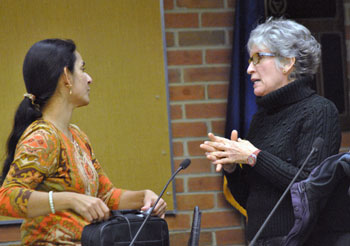
At left, Sumi Kailasapathy (Ward 1) chats with Kathe Wunderlich before the Feb. 11, 2013 city council work session. Wunderlich is with the Committee for Preserving Community Quality, which opposes the proposed extension of a runway at Ann Arbor’s municipal airport.
In the past, the city council has amended the CIP to exclude the runway extension. [For an explanation of why this was essentially outside the authority of the city council, see: "Ann Arbor Budget Process Starts Up"]
Sabra Briere (Ward 1) noted that last summer [on Aug. 20, 2012] the council had approved a continuation of the work on the environmental assessment (EA) for the airport. At the time, councilmembers had asked if that would be the last time they’d be asked for funding. She did not believe the EA had been completed. She thought the EA would be completed before the council would be asked to consider funding that project.
Matt Kulhanek, unit manager for fleet and facilities, told Briere that the EA had been completed and had been submitted to the technical operations group of the Federal Aviation Administration. It has been sitting at the FAA since September, he reported, and the city anticipated there would be a six-month time frame for the FAA to consider it.
Briere reiterated her point that in the next two months, the city council would be asked to approve a budget, and she didn’t see how the council could include the runway extension in the budget without seeing the EA. [Background on the EA: "Ann Arbor Airport Study Gets Public Hearing"]
By way of additional background, Pittsfield Township – along with the citizens group Committee for Preserving Community Quality – has filed a formal petition with the U.S. Secretary of Transportation asking for the federal approval and funding of the Ann Arbor municipal airport runway extension to be blocked. [.pdf of Jan. 28, 2013 petition filed with U.S. Secretary of Transportation]
Council CIP Concerns: Rail Transit – Station, Parking
Two projects related to possible east-west rail service drew scrutiny from councilmembers.
Current FY 2014 FY 2015 Project $0 $40,000 $500,000 A2-Detroit Commuter Parking (Interim) $0 $2.6M $0.00 Ann Arbor Station Final Design
-
Stephen Kunselman (Ward 3) asked about the interim parking project: “Where is that project? I never heard of that one.”
Responding to Kunselman’s question was the city’s transportation program manager, Eli Cooper. He explained that the project dates back three or four years when MDOT and SEMCOG (Southeast Michigan Council of Governments) began to announce that commuter rail service would be forthcoming. Those entities weren’t planning on providing parking at the existing station. So the city developed an interim strategy, Cooper said, and included the project in the CIP at that time.
Including it was consistent with putting MDOT and SEMCOG on notice that if they were to provide commuter service, they’d need to provide parking out of their budget too, Cooper indicated. The city’s strategy for parking is to use the existing MichCon site, immediately across the tracks from the existing station, Cooper said. The staff estimated there’d be space for a 100-vehicle parking lot, and the amount listed in the CIP was consistent with the estimated expense. The city had not based the estimated expense on conversations with MichCon, Cooper said. The numbers reflect simply a staff estimate of what it would take to establish and operate additional parking on an interim basis for 2-3 years.
Mike Anglin (Ward 5) wanted to know what the planning commission’s discussion had been like on the Ann Arbor Station design, when that body had deliberated on the CIP. Sabra Briere (Ward 1), who’s the city council appointee to the planning commission, indicated that the planning commission had not discussed the item.
Anglin said he was confused about the direction the city staff thought they had to continue with planning for the station.
By way of brief background, the location of a possible new Amtrak station is currently still the subject of a council-approved $2.75 million study, 20% of which the city is funding, with the remaining 80% covered by a federal grant. The council voted at its Oct. 15, 2012 meeting to approve the additional expenditure of $550,000 from the city’s general fund to cover the local portion of the match. Dissenting on that vote were Mike Anglin and Jane Lumm; Stephen Kunselman was absent.
At the Feb. 11 session, Cooper responded to Anglin’s question by citing the context of the city’s 2009 transportation plan update, which the city council had adopted. That document was reviewed by the planning commission as well and adopted as part of the city’s master plan. The transportation plan includes 20 years of transportation improvements – roughly $106 million of city-based improvements, and $100 million of state and transit-authority type improvements, Cooper said.
With that as the backdrop for his response, Cooper noted that the city has a preliminary grant for the study of the location for a new station, which is anticipated to be completed in roughly the next 18 months. The next logical sequence would be final design project, Cooper said. In that context, it’s the staff’s responsibility to include it in the CIP, he concluded.
Anglin sought clarification about a possible decision for the location of the station to be designed: Was it determined to be on Fuller Road? The location is undefined, Cooper said, and that’s why the title of the line item is “Ann Arbor Station,” with no specified location.
Council CIP Concerns: Bridges
Cresson Slotten explained that the city is mandated to inspect all its bridges every two years as part of the biennial bridge inspection program. But the city divides the bridges into two categories – those over water and those over land. In one year, the city inspects all the over-water bridges, and the next year the city inspects the remaining bridges. So every year, the city is engaged in the inspection of some bridges.
One bridge drew a question from Sabra Briere (Ward 1).
Current FY 2014 FY 2015 Project $317,000 $2.2 M $813,000 Fuller/Maiden/MedCenter Bridges Rehab
-
Briere noted that this particular bridge – even with a priority of 1 – has been originally included for FY 2017. Now it’s been shifted to 2014. What’s changed?
Nick Hutchinson, interim head of project management, told Briere that the project was originally put in the CIP for FY 2016-17, but was shifted up after the staff looked at the biennial bridge inspection reports. The city thought that doing the maintenance sooner would be more cost effective. Another factor leading to the shifting of the project to an earlier year, Hutchinson said, is a project in the works for the intersection there. The city wanted to get the projects done the same year. [On Feb. 7, 2011, the council authorized a $460,139 contract with DLZ Michigan Inc. to review previous studies of the Fuller Road/Maiden Lane/East Medical Center Drive intersection and propose a design for a reconfiguration of the intersection.]
Briere told Hutchinson that she would be really curious to see what the plan is for the Fuller Road/Maiden Lane/East Medical Center Drive intersection. She sees the bridge as a single system, and would like to see the bicycle path put under the bridge – as the bridge was designed to accommodate. Hutchinson told Briere he didn’t have a lot of detail to offer right then, but he knew it’s being studied.
Marcia Higgins (Ward 4) suggested that in replacing bridges, the city should try to partner with the University of Michigan, which has engineers working on flexible concrete and sophisticated sensors that allow for monitoring of stress remotely. Those approaches can allow identification of problems before they become visible.
Higgins felt that the city should be willing to participate in those university studies. Hutchinson reported that the city had had a meeting with engineering professor Victor Li, but the conversations haven’t gotten very far.
Council CIP Concerns: Barton Dam
Barton Dam is listed in two different items in the CIP.
Current FY 2014 FY 2015 Project $0 $100,000 $1.15 M Barton Dam Concrete Repairs $0 $0 $400,000 Barton Dam - Coating Struct. Steel
-
Christopher Taylor (Ward 3) asked for a description of the Barton Dam-related projects. Craig Hupy, public services area administrator, explained that the Barton Dam projects are listed with the water system projects because Barton Pond, which is formed by the dam, is the primary source of the city’s drinking water. Funding for the dam itself is in the general fund. The expectation is that work on the dam is split 50/50 between the general fund (based on the dam’s additional recreational purpose) and the drinking water fund.
There are several issues associated with the dam, Hupy said. One is that the system that controls the gates – used to regulate the flow of the water – does not allow for control as finely tuned as regulators would like. Hupy went on to explain that to maintain Barton Dam as a “run of the river dam,” for every drop of water that enters the pond, a drop needs to go over the dam to compensate. The dam was built in the early 1900s and has had a few technology upgrades since then. Currently, the mechanism allows for adjustments by one link of a chain – a fraction of an inch – which isn’t fine enough, he said, to avoid a pattern of opening gates then soon closing them again. The uneven flow is a point of friction with “the fisheries folks,” Hupy noted. [For additional background, see "How Low can Argo Flow Go?"]
In addition to the concrete and steel part of the dam, a roughly 3/8-mile long earthen embankment is part of the structure that forms Barton Pond, Hupy explained. FERC (Federal Energy Regulatory Commission) has required the city to do some investigative work, and the city thinks there’ll be some follow-up work required when that investigative work is completed. [FERC is involved as a regulator because the Barton Dam generates electricity.]
Responding to a question from Taylor about the anticipated cost of the additional work, Hupy indicated that it would be “six figures.” The city is putting about $400,000 total in various parts of the budget for it. But until the study work is completed later this spring, the amount can’t be more precise, Hupy indicated. Because Barton is a federally controlled dam, whatever the work the city does will be what the regulator demands that the city does or doesn’t do. “Stay tuned,” Hupy told Taylor.
The Chronicle could not survive without regular voluntary subscriptions to support our coverage of public bodies like the Ann Arbor city council. Click this link for details: Subscribe to The Chronicle. And if you’re already supporting us, please encourage your friends, neighbors and colleagues to help support The Chronicle, too!






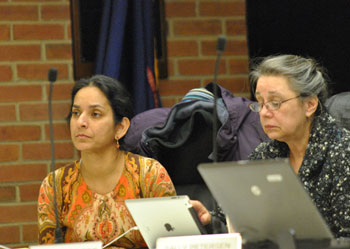
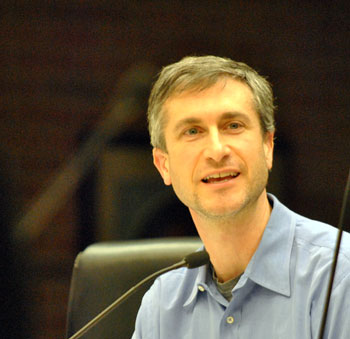
Perceived immediate need aside, the runway expansion would provide a very short-lived benefit (if any).
Air travel will continue to decline. It’s only a matter of years, not decades before rising fuel prices (after a brief drop) and rapidly decreasing availability—combined with falling discretionary income, business activity, etc.—make air travel unaffordable for most people, businesses included. Not long after that the fuel simply won’t be available.
We can’t afford to waste $2.14 million. To point to one related alternative investment, it could go toward improving broadband infrastructure instead.
Why is it that every time we’re asked to fund commuter rail, the money goes toward parking and expensive consultants?